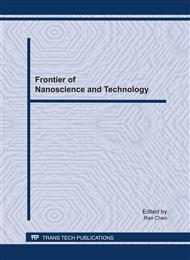p.760
p.764
p.769
p.773
p.778
p.783
p.788
p.794
p.799
Research on Interfacial Coordination of Trigonal Schiff Base Compound with Hydrophobic Core and Aromatic Periphery at Air/Water Interface
Abstract:
Great interest has been given to the Schiff base amphiphiles with special molecular structures because of their unique properties. In this article, we report some interesting properties of the interfacial films formed by a newly designed trigonal amphiphiles Schiff base containing hydrophobic core and aromatic periphery. This novel Schiff base amphiphile could be spread to form stable monolayers and coordinated with Cu(Ac)2 in situ in the monolayer. The coordination with Cu(II) ion has a great effect on the regulation of the properties of the Langmuir monolayers. A larger limiting molecular area was observed for the monolayers of the trigonal amphiphile on Cu(II) ions subphase. Both the monolayers on water and on the aqueous Cu(Ac)2 subphase were transferred onto solid substrates, and different morphologies were observed for films. The present work provided new insight into the design and interfacial assembly of novel Schiff base amphiphiles with special molecular structures and substituted groups.
Info:
Periodical:
Pages:
778-782
Citation:
Online since:
July 2011
Authors:
Price:
Сopyright:
© 2011 Trans Tech Publications Ltd. All Rights Reserved
Share:
Citation:


